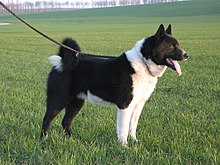Karelian Bear Dog

An adult Karelian Bear Dog
|
|||||||||||||||||||||
| Other names | Karjalankarhukoira Karelsk Björnhund |
||||||||||||||||||||
|---|---|---|---|---|---|---|---|---|---|---|---|---|---|---|---|---|---|---|---|---|---|
| Origin | Finland | ||||||||||||||||||||
|
|||||||||||||||||||||
| Domestic dog (Canis lupus familiaris) | |||||||||||||||||||||
| Classification / standards | |||
|---|---|---|---|
| FCI | Group 5, Section 2 Nordic Hunting Dogs #48 | standard | |
| AKC | FSS | ||
| The AKC Foundation Stock Service (FSS) is an optional recording service for purebred dogs that are not yet eligible for AKC registration. | |||
| CKC | Group 3 - Working Dogs | standard | |
| UKC | Northern Breed | standard | |
The Karelian Bear Dog (KBD) is a Finnish or Karelian breed of dog. In its home country, it is regarded as a national treasure. KBD will hunt a variety of animals. Its quick reflexes and fearless nature have made it very popular for hunting aggressive game, including bears, moose, and wild boar. It was the breed's ability to hunt and offer protection against a bear that earned the breed its name.
According to archaeological records, dogs very similar to the modern Russo-European Laika and the Karelian Bear Dog existed in northeastern Europe and Scandinavia since Neolithic times. The breed standard for KBDs and Laikas today calls for a black-and-white marked dog, but originally the breed included individuals with coats of wolf gray of various shades, red coats like the standard spitz, and black-and-tan specimens as well.
The Karelian Bear Dog was used mainly for hunting small fur-bearing animals, such as squirrels and marten. Like the Norwegian Elkhound, the Karelian Bear Dog was also used in hunting moose, lynx, wolf and, as its name would suggest, hunting the Eurasian brown bear. In hunting bear, at least a pair of Bear Dogs would be used to harry the animal, barking loudly, in order to distract the bear while the human hunter came in for the kill.
Karelian Bear Dogs have been used for bear control at Yosemite and Glacier national parks, and with the Washington State Department of Fish and Wildlife.
Males stand 54–60 cm (21–24 in) at the withers; females are shorter, at 49–55 cm (19–22 in). Both sexes weigh 20–23 kg (44.1–50.7 lbs).
The breed has a coat of straight, stiff guard hairs and a fine, soft, thick undercoat. There should be no curl in the hair at all. The colour must be black with white markings. Often the jet black hair is slightly tinted with brownish highlights on the ends giving it an iridescent quality. Preferably the color percentage is around 70% black and 30% white. The bushy tail curls in a circle over the back in a ring and has a white tip. It falls gently onto the dog's back or to one side. Purebred KBD have tails that curve into a circle rather than a sickle.
...
Wikipedia
